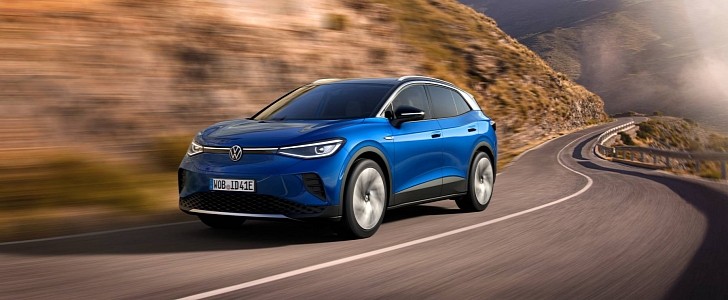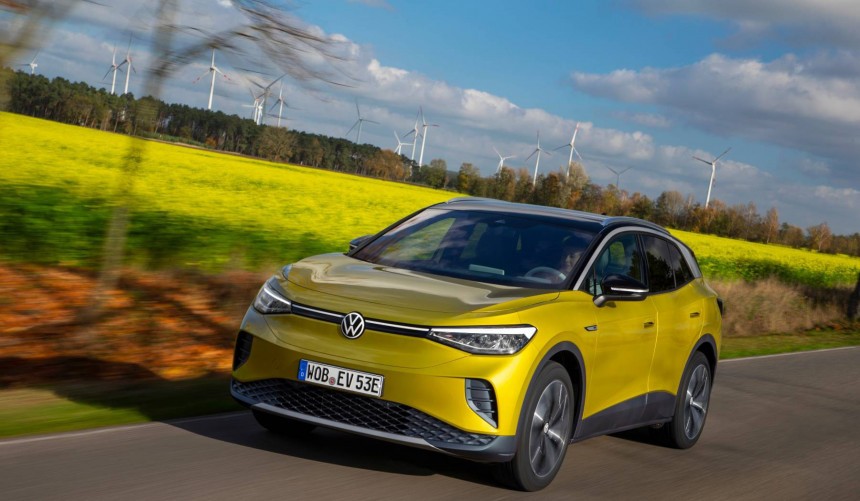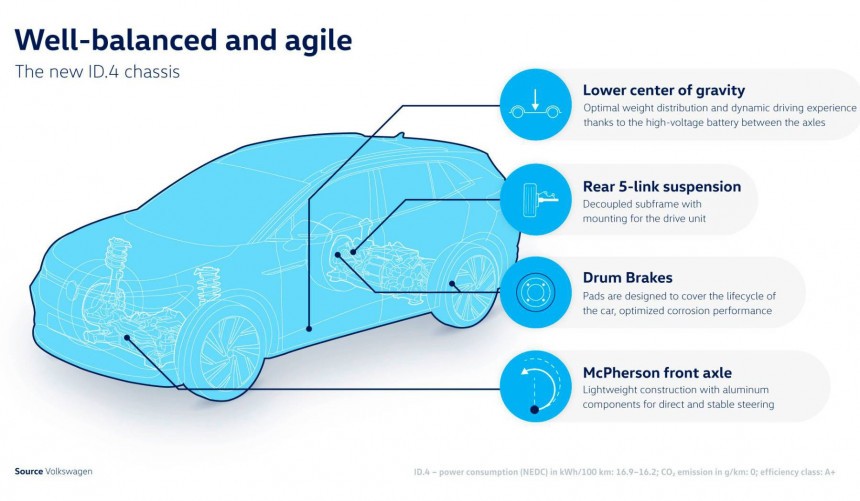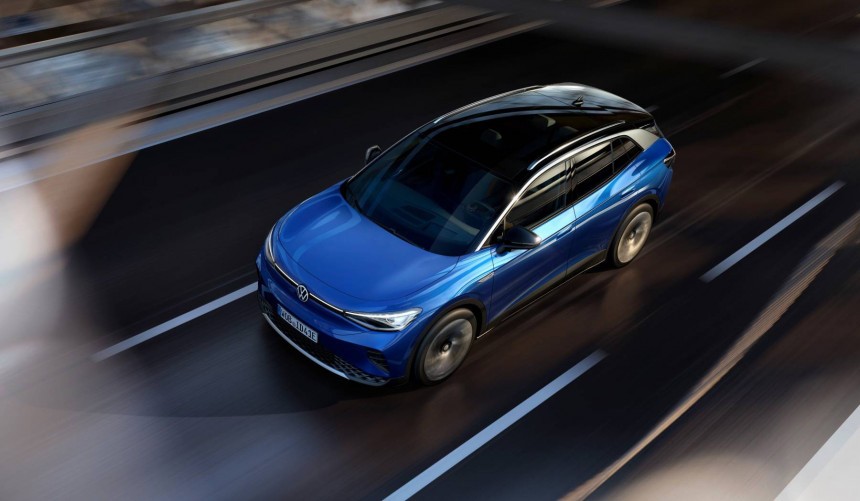The first all-electric crossover SUV manufactured under the Volkswagen brand is based on the group’s MEB platform and is marketed as an affordable, versatile EV that drives like a sports car, and will be VW’s first EV model to be made available globally.
The focus of development was to offer a spacious yet compact all-rounder that is easy and fun to drive. The sporty handling is made possible by the rear-wheel-drive and high-voltage battery that is placed between the two axles, at the lowest possible point of the vehicle.
This lowers the center of gravity and aids weight distribution, which is equally spread over the front and rear wheels. This enables drivers of the new ID.4 to attack corners with almost the same aggressiveness and confidence as they would with a sports car.
For the first time on a VW vehicle, the steering system is positioned ahead of the wheel’s center, which assures high stability in fast corners. Moreover, the ratio of 15.9:1 makes steering more precise.
The Plus sports package available with the top-of-the-range ID.4 Max features progressive steering, which dynamically adapts the ratio from the default 15.9:1 up to 14.5:1.
Also included in this package is the DCC adaptive chassis control. It changes the parameters of each damper depending on the road surface and conditions. The innovative technology is capable of 200 adjustments per second.
These two advanced features can be enjoyed differently, according to the selected driver mode. Three of them are preconfigured (Eco, Comfort, and Sport) while the fourth (individual) allows the driver to modify each suspension and chassis setting for a unique driving experience.
The new ID.4 borrows the Vehicle Dynamics Manager system from the latest Golf GTI. It works closely with the stability control module (ESC) to control the brake intervention of the XDS electronic transverse drive lock.
The ingenious traction control system is speed-based, which means that the rear wheel-driven ID.4 is stuck to the road even in an extreme situation, electronically counteracting oversteer, a traditional issue with conventional RWD vehicles.
To further improve handling, the SUV features a front McPherson suspension that exponentially reduces weight compared to a conventional double-wishbone design. Components are made of high-strength aluminum that improves rigidity and allows more stable steering.
On the rear, engineers have designed a compact five-link suspension with a flexible subframe that is connected to the body.
The E-SUV is available with a multitude of wheels that range from 18 to 21 inches in diameter. They are aerodynamically perfected and roll off the production line with low resistance tires that are wider on the rear wheels.
Using larger wheels has enabled engineers to develop a robust braking system that features big rotors in the front and drum brakes on the rear axle, which use pads that are guaranteed to last for the entire lifespan of the vehicle.
The final production version of the nimble ID.4 was recently introduced and will be available in eight models in the near future. The first North American version will be available in the first quarter of 2021 with a single rear motor that develops 201 hp (204 PS; 150 kW) and can tow up to 2,700 lb. (1,225 kg). It will be powered by an 82 kWh battery pack that offers an estimated driving range of 250 mi (402 km) on a full charge.
An AWD version will be introduced later in 2021 and will feature two rear motors that combine for an output of 302 hp (306 PS; 225 kW).
In the U.S., the ID.4 will be available with three years of DC fast charging using the Electrify America network, for no additional cost.
For the European markets, the RWD, single motor ID.4 is available with three power options that range from 146 hp (148 PS; 109 kW) to 201 hp (204 PS; 150 kW. The battery pack is available with 52 or 77 kWh capacity (net), and a range of up to 520 km (324 mi).
This lowers the center of gravity and aids weight distribution, which is equally spread over the front and rear wheels. This enables drivers of the new ID.4 to attack corners with almost the same aggressiveness and confidence as they would with a sports car.
The Plus sports package available with the top-of-the-range ID.4 Max features progressive steering, which dynamically adapts the ratio from the default 15.9:1 up to 14.5:1.
Also included in this package is the DCC adaptive chassis control. It changes the parameters of each damper depending on the road surface and conditions. The innovative technology is capable of 200 adjustments per second.
These two advanced features can be enjoyed differently, according to the selected driver mode. Three of them are preconfigured (Eco, Comfort, and Sport) while the fourth (individual) allows the driver to modify each suspension and chassis setting for a unique driving experience.
The new ID.4 borrows the Vehicle Dynamics Manager system from the latest Golf GTI. It works closely with the stability control module (ESC) to control the brake intervention of the XDS electronic transverse drive lock.
To further improve handling, the SUV features a front McPherson suspension that exponentially reduces weight compared to a conventional double-wishbone design. Components are made of high-strength aluminum that improves rigidity and allows more stable steering.
On the rear, engineers have designed a compact five-link suspension with a flexible subframe that is connected to the body.
The E-SUV is available with a multitude of wheels that range from 18 to 21 inches in diameter. They are aerodynamically perfected and roll off the production line with low resistance tires that are wider on the rear wheels.
Using larger wheels has enabled engineers to develop a robust braking system that features big rotors in the front and drum brakes on the rear axle, which use pads that are guaranteed to last for the entire lifespan of the vehicle.
An AWD version will be introduced later in 2021 and will feature two rear motors that combine for an output of 302 hp (306 PS; 225 kW).
In the U.S., the ID.4 will be available with three years of DC fast charging using the Electrify America network, for no additional cost.
For the European markets, the RWD, single motor ID.4 is available with three power options that range from 146 hp (148 PS; 109 kW) to 201 hp (204 PS; 150 kW. The battery pack is available with 52 or 77 kWh capacity (net), and a range of up to 520 km (324 mi).











